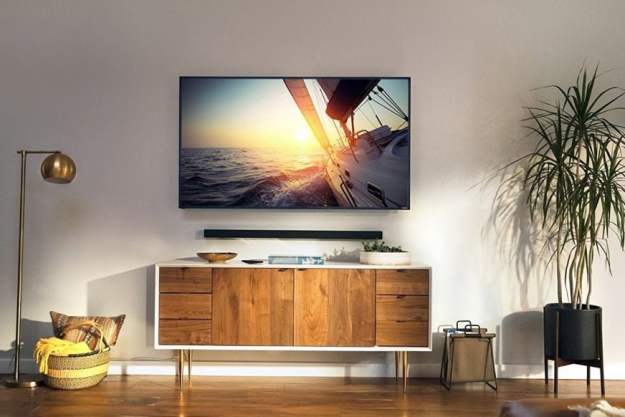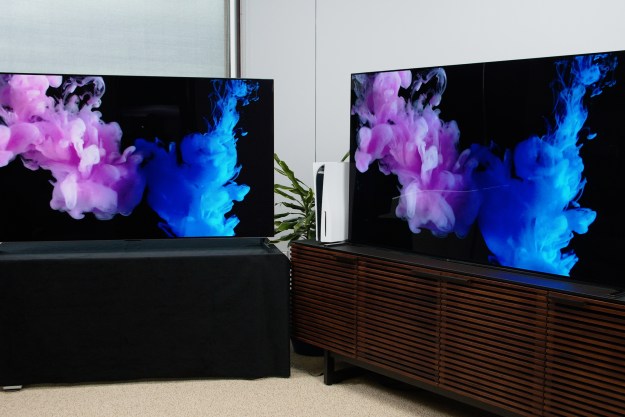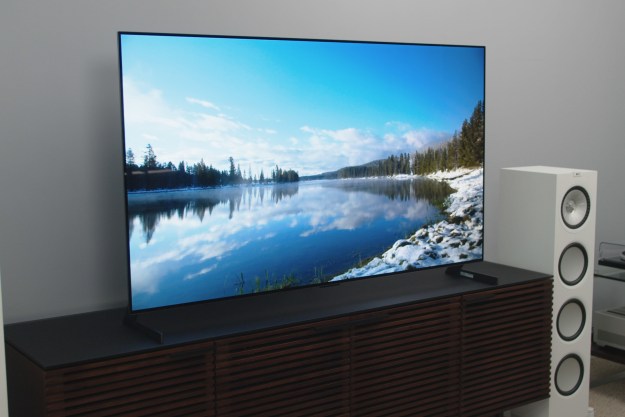
“LG's most gorgeous OLED TV yet.”
- Stunning design
- Excellent picture quality
- Top-notch HDR/contrast
- Improved user experience
- Excellent for gaming
- Pricey premium for design
- Stand sold separately (wall-mount only)
LG made its bed. Now it has to lie in it.
After years as the sole OLED TV producer in the U.S., other manufacturers have caved. The first holdout to succumb was Sony. And now Vizio is on board, Philips is sending an OLED to the U.S., and budget brand Konka is getting into the mix.
Now that LG has so many roommates moving into the house it built, it has to fight to secure the master suite. That means making the best, most desirable OLED TVs on the market. It’s likely LG won’t ever be the most affordable option, so it has to lean hard into premium options to seduce customers.
Enter the 2020 LG Gallery Series GX OLED, one of the best TVs out there. Its signature design elements are a so-called “no-gap, no-shadow” wall mount system and extremely thin profile. An apparent answer to Samsung’s no-gap wall mount approach (available for select Samsung Q-Series TVs dating back to 2017), LG has created its own work of art that pairs the inherently ultra-thin characteristics of an OLED panel with keen engineering that somehow keeps all the electronics in a shallow chassis.

This stunning design comes at a price, albeit a lower premium than I expected. In fact, LG’s OLED TV prices are lower across the board. Still, a 65-inch GX costs $3,500, while the 65-inch CX step-down model, — which offers the same great picture quality — comes in at $2,800. Neither is affordable, but does the Gallery Series deserve the $700 premium?
If looks could kill, the LG GX OLED would be a serial killer.
I’m unsure. I think the answer will come down to how much value aesthetics hold for you. One thing, however, is quite certain. If looks could kill, the LG GX OLED would be a serial killer.
LG Gallery Series GX Details
While we reviewed the 65-inch OLED65GXPUA model, our review also applies to the 55-inch and 77-inch models.
| Screen Size | Model Number | MSRP |
| 55-inch | OLED55GXPUA | $2,699.99 |
| 65-inch | OLED65GXPUA | $3,499.99 |
| 77-inch | OLED77GXPUA | $5,999.99 |
Out of the box
Fun story: I wasn’t expecting the GX (pronounced G 10) OLED TV for this review. I was expecting the CX model, and when I took a very carefully orchestrated, socially distanced delivery of this TV, I didn’t look closely at the box.
In order to shoot an unboxing video during a global pandemic, I asked my video producer, Dan Baker, to unbox the TV by himself while documenting B-roll for our video. Word came down from Dan:, “There’s no stand. No legs. I think we’re missing some parts.”
A brief call with LG revealed that I had indeed been quite intentionally lined up with a GX OLED and that the TV does not ship with legs, but does ship with the no-gap wall mount — an accessory for which Samsung charges $150 extra. The fact that I had not received the legs was an unfortunate consequence of office closures due to coronavirus lockdown orders.
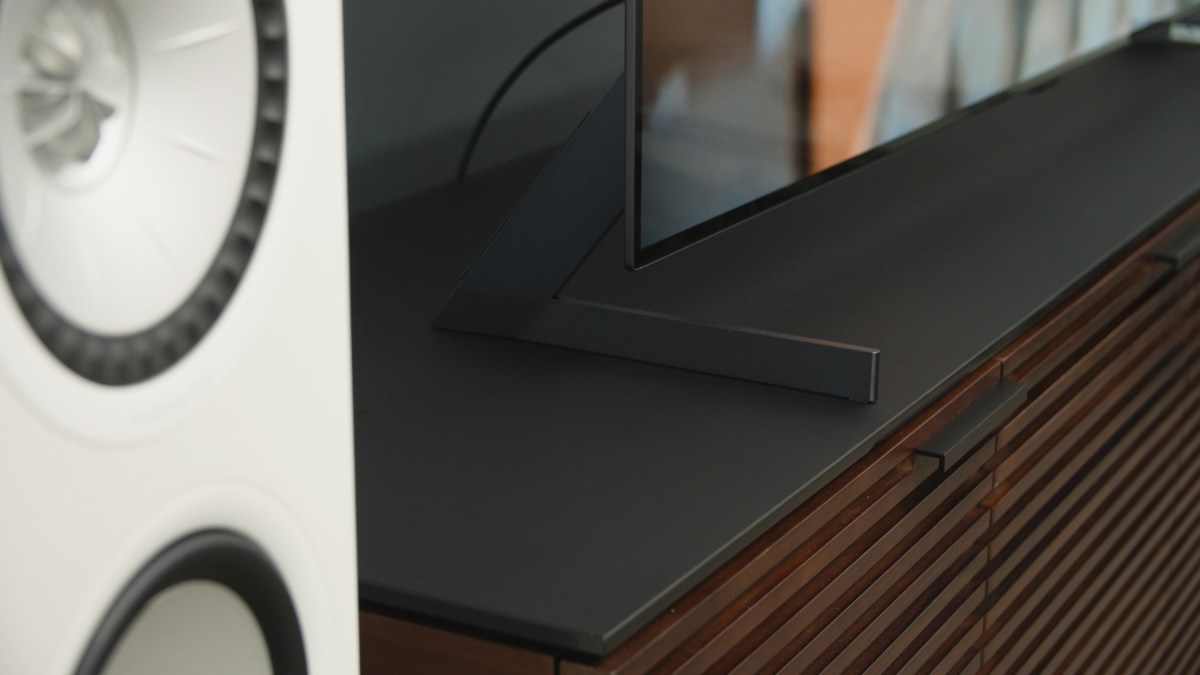
Three days later, I got the legs and decorative plastic panels — accessories for which LG charges extra.
Bottom line? This TV is created to be wall-mounted. It makes no sense to put it on a credenza or entertainment stand, save perhaps for enjoying its extra-thin profile. If you’re not planning to wall mount, I’d steer you toward the CX series.
Made to mount
I’m a fan of LG’s wall mount for the GX OLED. The smart, one-piece design is compact, robustly built, and easy to install. Thanks to articulating arms, the TV can be pulled out from the wall. That’s not so much for adjusting the horizontal viewing angle (which is unnecessary with an OLED TV with ultra-wide viewability), but to make access to the TV’s inputs easy.
I was surprised at the weight of this GX OLED, which tips the scales at 65.7 pounds. It isn’t unmanageable, and one can still mount the TV using provided drywall anchors, but I would advise drilling into studs where possible.
Picture quality
I’ve been impressed with the mini-LED and micro-LED TV technologies that other manufacturers are starting to play around with, but at the end of the day, my heart still belongs to OLED, and the GX is one of the prettiest examples I’ve seen yet.
Despite valiant efforts to abate the problems inherent to LCD TVs and the LED backlights they rely on, nothing beats a self-emissive display for black levels, screen uniformity, and stunning contrast. Presently, OLED is the best it gets. And LG’s 2020 OLEDs look better than ever, even if the improvements are slight compared to last year’s models.
Currently, LG’s only real competition comes from Sony. As mentioned before, that will change later this year. But if I had to decide between a 2020 LG OLED and a 2020 Sony OLED, I’d have to pick the LG based on features alone. The Sony A8H is coming, and I’ll be able to directly compare LG against its Sony competition, but I have to imagine any appreciable difference in picture quality going in Sony’s favor is likely to be overridden by the better package deal LG’s OLED TVs represent.
As for the GX series? I don’t see it being the best choice for everyone, based on cost. However, the TV’s aesthetic is undeniably sexy, and LG has every right to charge a little extra for it. That sole reason prevents me from giving this TV a perfect 5 out of 5 stars. Otherwise, this TV is a huge win for LG and its customers.
User experience
The GX OLED may be a looker from the outside, but nearly all other improvements for 2020 are hidden inside.
WebOS, LG’s smart TV platform and operating system, has been overhauled and the improvement is noticeable. While I’ve always felt webOS was approachable and easy to use, lately it has been feeling a little dated.
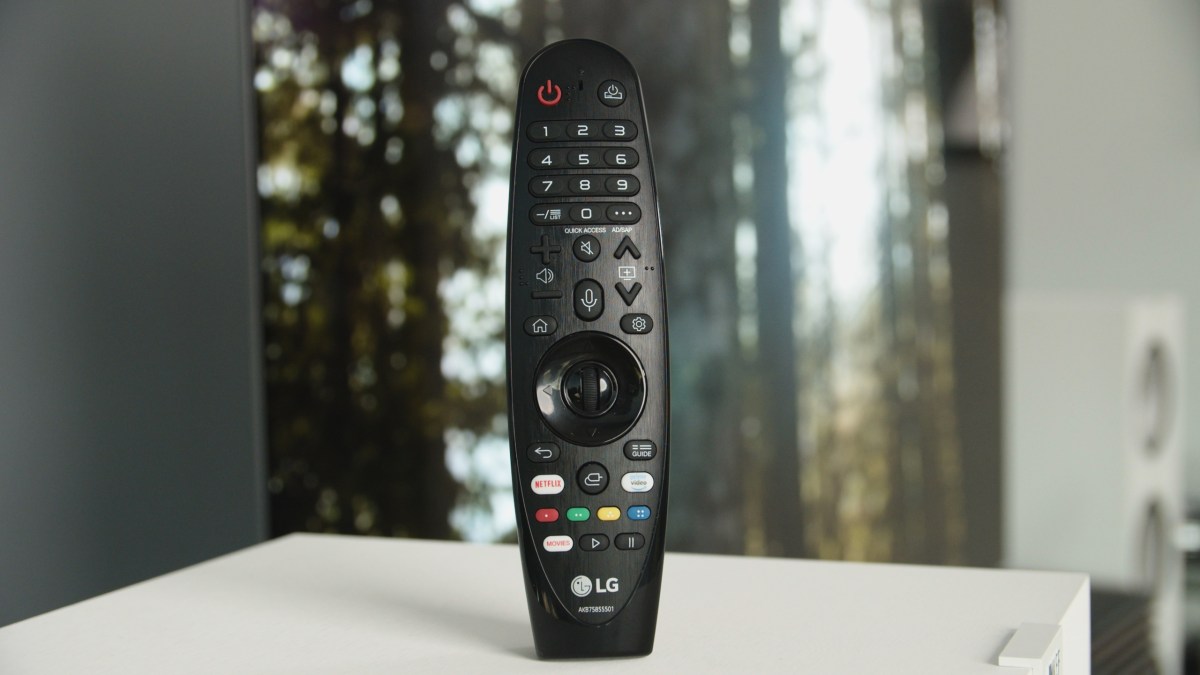
The new version of webOS looks and feels much more professional. There are fewer splashes of color and more transparent backgrounds, and the menus are simply more legible.
The home screen shows more apps at a time, which makes getting to Disney+, Apple TV+, or ESPN just as easy as Netflix or Hulu. You’ve always been able to order the apps any way you like, but now you get to see more of them at one time.
The home screen also takes up less of the screen, closer to one-third of the bottom, instead of one-half.
Within webOS, there are a couple of fun features, although one in particular is sadly useless for the time being — again due to the coronavirus. Sports alerts allow users to pick their favorite teams and get on-screen alarms for game times, game score updates, and at-a-glance highlights.
Another new feature, called “Who. Where. What?” attempts to make live TV more interactive by answering voice queries on who the actors are, where a scene is located, and what some of the products on the screen may be. It’s a fun idea. but I’ve yet to get it to work in practice.
Speaking of voice interactions, LG’s own voice assistant is smarter and more capable, better recognizing natural language and providing more personable responses. Interactions feel more like talking to a person than a robot, and where the LG assistant’s abilities trail off, Google Assistant takes over. For instance, LG’s assistant can help you find content or change the channel, while
The GX also offers far-field voice control, if you want to use it. There’s a microphone and mic button on LG’s magic motion remote, as is the case with all LG OLEDs. However, the GX series now has a mic built into the TV, and the wake words “Hi LG” will trigger the assistant.
Enhanced processing
At the heart of LG’s 2020 OLED TVs (save the entry-level BX model) is the Alpha 9 Gen 3 processor. With it comes a couple of valuable improvements. My favorite is a new A.I. picture mode that helps optimize picture performance by analyzing ambient light in the room and making picture setting corrections on the fly.
This may sound familiar, but the feature goes beyond basic “eco modes” by adjusting the TV’s electro-optical transfer function (EOTF) to maintain bright details and
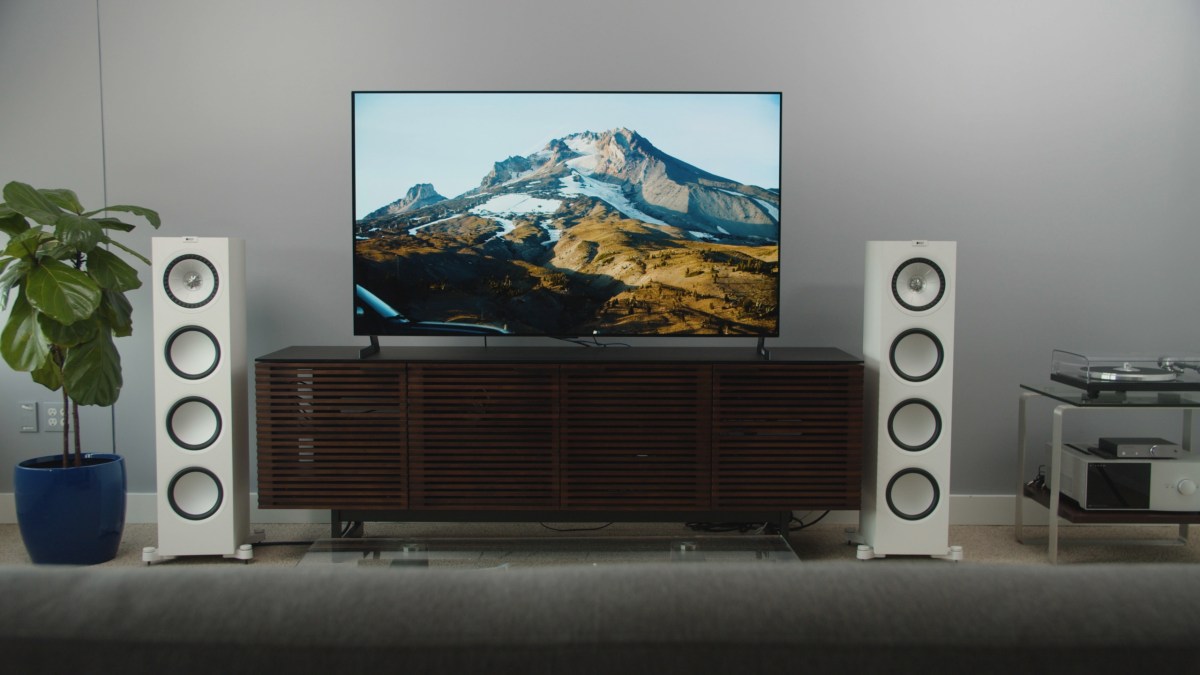
Other improvements are a bit technical, but do result in picture-quality improvements. I’ve noticed the Alpha 9 Gen 3’s de-contouring filter does a better job of minimizing banding in broad color areas, particularly with low-bit rate content, where banding is often a problem. The result is a much smoother picture with less distractions.
LG’s dynamic tone mapping is also improved. What this means to viewers is a better
LG also added a feature to increase peak brightness for SDR content that allows it to look a little more vibrant — like
Speaking of picture modes, users will find Filmmaker Mode installed on LG’s OLEDs this year, including the GX. This picture mode disables all of the post-processing reviewers hate, eliminating soap opera effect, keeping colors accurate, and maintaining aspect ratio and original frame rate.
Frankly, Filmmaker mode looks a lot like ISF Calibrated Dark to me. As I watch more content, I’ll be sure to update my commentary here. For out-of-box picture settings, I’m still recommending ISF Calibrated Bright or ISF Calibrated Dark as a starting point.
Gaming performance
Outfitted with full-spec HDMI 2.1 ports and every available gamer-friendly feature, LG’s 2020 OLEDs make a compelling case for gamers looking for a large-format display on which to play. So far, LG’s OLED TVs are the only models to support both Freesync and G-Sync, along with variable refresh rate (VRR). They also support auto low latency mode (ALLM) , with lag times as low as 13 milliseconds.
LG’s OLEDs are also the first to add an HGiG mode, which should dramatically improve
Simply put, this TV kicks your gaming monitor’s ass.
In a nutshell, HGiG supports TVs behaving in a predictable way, such that game rendering engines handle all of the
While burn-in remains a concern for some applications, LG OLEDs make a lot of sense for gamers this year. Simply put, this TV kicks your gaming monitor’s ass.
Our Take
LG’s Gallery Series GX OLED begs a premium, but the added investment is returned in the form of gorgeous design, a slick wall mount system, and improved user experience. Toss in LG’s outstanding OLED picture quality, and you have one astounding TV.
Is there a better alternative?
I think the LG CX OLED will make more sense for most people. It isn’t as svelte, nor will it look quite as sexy on a wall, but it is less expensive and offers the same picture quality and user-facing features as the GX, save the hands-free voice control mentioned earlier.
For a non-OLED option, one could consider the Samsung Q90T for an equally premium LCD/LED display.
If Vizio and Philips start shipping OLEDs in the U.S., I will update this section of the review.
How long will it last?
Given its support of HDMI 2.1 and all the features that come with it, this TV is positioned to last well into the future.
Warranty
LG offers a 1-year limited parts and labor warranty. This warranty does not cover image retention, also known as burn-in.
Should you buy it?
Yes. If you appreciate the GX’s slim profile and unique no-gap wall mount feature and can afford the premium, go for it. I can confidently say that if cost was no object, I would buy the LG GX OLED right now. It’s the most compelling TV I’ve reviewed to date.
Some of you might be looking for discounted alternatives too. Check out our list for the best 4K TV deals if you want to know more.
Editors' Recommendations
- Best Sony TV deals: Save on best-in-class 4K TVs and 8K TVs
- Sony debuts the Bravia 9, its brightest 4K TV ever, alongside new 2024 models
- Best OLED TV deals: Save on LG C3, Samsung S90C, and more
- LG TV deals: Get a 70-inch 4K TV for under $650
- Best TCL TV deals: 4K TVs as low as $150


